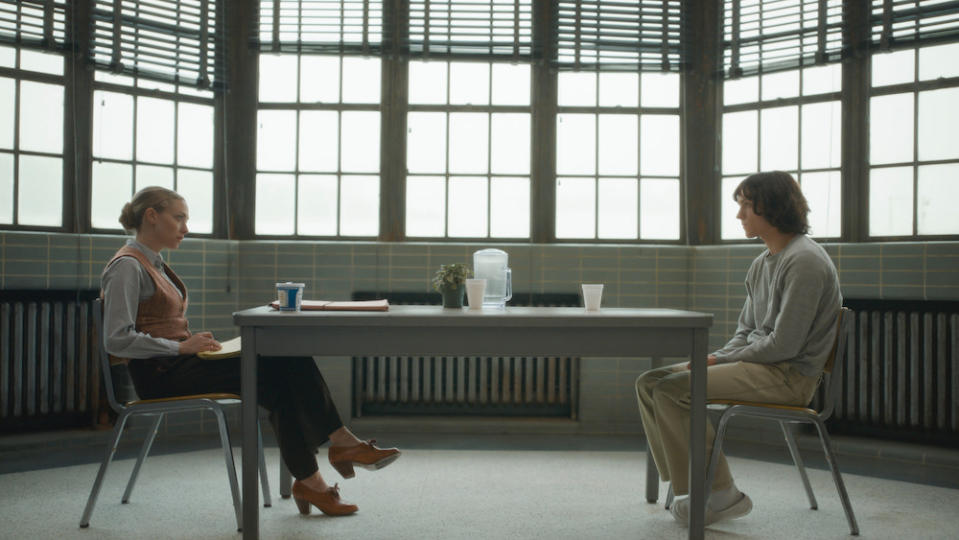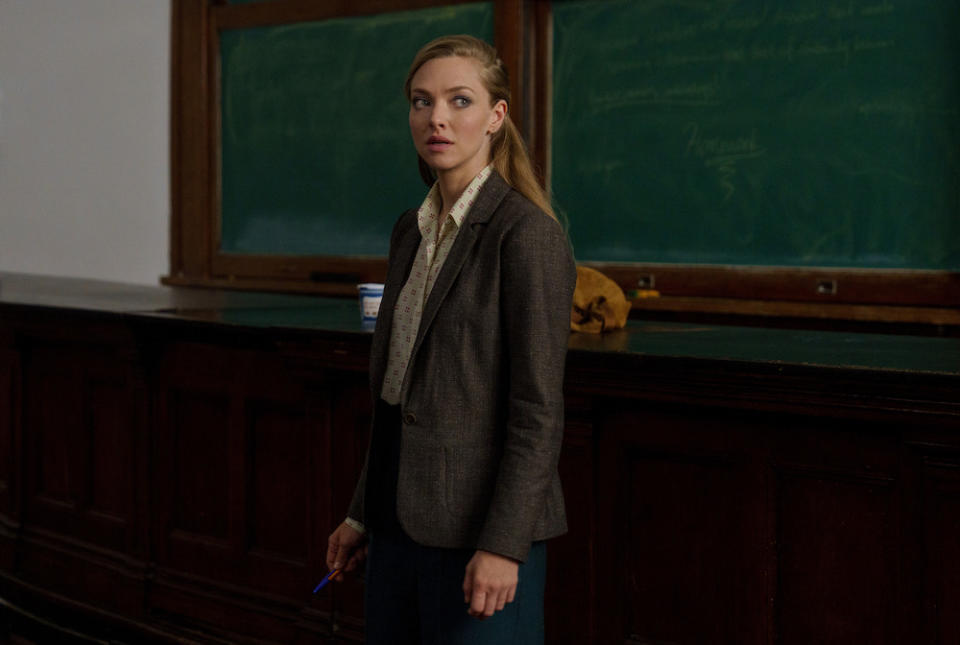‘The Crowded Room’ Review: Tom Holland’s Apple Drama Is Well-Intentioned but Exasperating

- Oops!Something went wrong.Please try again later.
What restricts and ultimately fells “The Crowded Room” isn’t just one poor decision. Far too long and visually repetitive, the 10-episode limited series starring Tom Holland and Amanda Seyfried doesn’t have the dramatic heft needed to justify its length, nor is its narrative crafted carefully enough to build proper momentum. Holland’s lead performance is solid, though irreparably hampered by the story’s structure, and Seyfried’s is a tad sharper, though that could be because she’s able to do more with less. Its message — which I can’t even get into for reasons I’ll divulge shortly — is significant and stirring, which makes you wish how it’s conveyed was that much stronger.
But there is a key creative decision that connects all these hang-ups; a choice so frustrating before it’s understood and exasperating once it’s explained that you can’t help but wish writer-creator Akiva Goldsman could go back and remake “The Crowded Room” before anyone has to sit through the bad version. I will tell you what that choice is, dear reader, but I must also abide by the wishes of the creator. Goldsman wrote a letter to critics, included in our advanced screeners, that asks us not to spoil a handful of key plot points… as well as the basic premise of his series.
More from IndieWire
While I tend to be extra-sensitive to spoilers — trying to avoid anything I, as a viewer, would rather discover onscreen than read in a review — what’s being asked here is next to impossible. Exactly what makes “The Crowded Room” fundamentally admirable and sporadically involving is inextricably linked with what makes it routinely faulty and far too tedious (again, because it’s the show’s central concept). Not discussing it would betray my review’s purpose and value to readers, just as “The Crowded Room” holding it back does a disservice to its own purpose and value to viewers.
So, here’s my solution: Below, you will find two reviews. The first is what Goldsman and Apple consider to be spoiler free. The second is what I consider to be spoiler free, which will include the show’s premise (but not its ending or many “twists”). Choose your own adventure. And if you can’t choose, just scroll to the bottom for the grade. Unless you’re already dead-set on watching (or not watching), that may be all you need, anyway.
Review No. 1 – No Spoilers, No Premise
Danny (Tom Holland), a young man with the worst haircut you’ve ever seen this side of a sketch comedy, emerges from the 50th St. subway stop with his friend, Ariana (Sasha Lane). After spotting their target, Ariana cuts him off and Danny pulls a gun out of a brown paper bag, pointing it at the unseen pedestrian. But he can’t do it. Danny freezes. Ariana shouts at him, begging him to shoot, but he won’t, so she grabs the gun, chases the man, and fires until she’s out of bullets. Then she drops the gun and chases after the still-unknown victim. Danny, coming out of his stupor, picks up the gun and runs away.
Cut to: Rya Goodwin (Amanda Seyfried) is talking to the cops about Danny’s case. From what they’ve been told, Danny and “the girl” were just planning to scare someone — the man is wounded but fine, and no one was killed. Still, for reasons that aren’t entirely clear at the time, one of the detectives (Thomas Sadoski) seems to think they’ve caught a serial killer, and he asks Rya to go talk to Danny and find out what else he may have done. So she does, and Danny eventually starts recounting his life story.
From there, “The Crowded Room” bounces between his flashbacks and their conversations. Turns out Danny was “sad and moody” as a teenager, which alienated from his peers and pissed off his jerk of a step-father, Marlin (Will Chase). He has a few loyal friends, and they help him whenever they can — hiding pot from the principal, helping him score a date with the cute new transfer student, and protecting him (when possible) from bullies.

Danny’s adolescence isn’t all that different from many teen experiences (and not all that compelling on its own), until he stumbles upon The Ghost House — a long-empty home near his mom’s place that soon gets a new tenant: Yitzhak (Lior Raz). Quiet and built like an ox, Yitzhak and Danny don’t really talk until one day when he gets in a fight right outside The Ghost House. Yitzhak intervenes, scaring away Danny’s tormentors, and he quickly invites Danny to move in with him. While a strange, even dangerous choice to outsiders, Danny sees Yitzhak as his protector — not only from bullies, but from his bad step-dad.
“You never thought it was strange that this man just showed up and saved you?” Rya asks Danny, when first hearing this part of his story. “No,” Danny says. “I didn’t. Not at the time.” Curiosity-spiking observations like these are peppered into the opening episode, inviting questions that aren’t plainly answered for some time. Stilted sequences — where dialogue seems selectively truncated or that start and end in odd places — give the same secretive effect. Yet “The Crowded Room” presses on, as Danny makes new friends at The Ghost House and even goes searching for his biological father.
To say what’s happening doesn’t always add up is the least of the show’s problems. Rarely does it feel like the show doesn’t know what it’s doing, so much as it’s clearly holding back key information from the audience. If what these chosen events had momentum on their own, that would be fine, but “The Crowded Room” is too low-stakes, too obscured, and too drawn-out to maintain interest in Danny alone. (And watching the 27-year-old Holland play another misfit teen, sans superpowers or awkward charm, isn’t exactly a treat.) Why is this guy worth so much time? What makes a non-fatal shooting — where he didn’t even pull the trigger — so important to the cops? How can whatever he’s not telling us make up for the trite nature of what he has shared?
Goldsman, who wrote every episode, tries to drop half-baked red herrings that Danny is a serial killer, but there’s an identifiable lack of conviction to the claims. After the first hour, if not far sooner, the only reason to keep watching is to figure out what the hell is really going on, and by the time that answer comes, it’s both obvious and infuriating. “The Crowded Room” is compassionate and substantive, but only for reasons that show up far too late in the 10-hour series — and that I can’t get into here.
Review No. 2 – With Spoilers for the Premise!

What Goldsman and Apple don’t want you to know, for reasons that defy logic, is that “The Crowded Room” is inspired by Daniel Keyes’ 1981 non-fiction book, “The Minds of Billy Milligan.” While the real-life subject of the novel is quite different than Danny, the critical link between the two of them is they both suffer from dissociative identity disorder (often referred to as multiple personality disorder), and they both have to prove their diagnosis is real in a court of law. If they can’t, they’ll go to prison for a long, long time. If they can, they’ll get the mental health care they so desperately need.
Now, film and television have tackled DID so often it tends to elicit more groans than gasps when used as a twist. Since “Sybil” (which gets name-checked in “The Crowded Room”) and through “Primal Fear,” “Fight Club,” “Hide and Seek,” “Identity,” “Shutter Island,” and dozens more, audiences have been trained to be on the lookout for characters who only exist in the main character’s head, and plenty of alarm bells go off in the early hours of Danny’s story. For one, it’s made clear from the jump that when he’s talking to Rya, he’s not talking to a cop; he’s talking to a psychologist. For another, when said psychologist asks him question after question about how convenient it is for a new friend to show up just when Danny needs one, or how these friends were able to know things only Danny knows — it’s pretty clear what Rya believes.
For the explicit effort made by Apple and Goldsman to keep people from talking about the core conceit of their show, “The Crowded Room” isn’t all that concerned about hiding it in the storytelling. The serial killer theory is so half-assed I almost forgot it existed. The hints as to what’s really going on are given so quickly and unmistakably, I believed Danny had DID long before the “twist” was revealed — and the reveal itself is hardly emphatic. “Fight Club” this is not. Danny’s disorder is unveiled so slowly, one could argue the confirmation comes at the end of multiple episodes, which not only deadens its impact but works against the show’s central message.
The series’ back-half serves as a rebuttal to all those other movies and shows that deploy dissociative identity disorder as a cheap hook. Originally conceived as an anthology, where each new season would examine a different mental illness, the story goes out of its way to address how the general public (and even the medical community) can be quick to dismiss what they don’t understand. Rya’s arc can sometimes feel like filler, in order to substantiate an Emmy-winning talent like Seyfried’s involvement, but at its best, she’s educating the audience while she’s helping her patient. Her bond to Danny goes beyond an obligation to this one specific case and speaks to larger problems in the field of psychology, from institutionalized sexism to widespread acceptance of its legitimacy.
Mental illness is not like a physical ailment; you can’t see the healing happen with your own eyes, and even the patient doesn’t always feel better during the healing process. “The Crowded Room” understands this and can convey its complicated nature with both clarity and force. Goldsman’s letter to critics even includes the line: “I created ‘The Crowded Room’ with a singular purpose: to generate empathy for those who suffer from mental illness.”
So… why bother with hiding it? Honestly, “The Crowded Room” is trying to have its cake and eat it, too. It wants to be the corrective to all those lazy D.I.D. tales, while still indulging in their twisty storytelling. Had the series simply leaned into its own goals, its own raison d’être, Holland would’ve had ample opportunity to show off his range (the dream of any actor taking on a role with so many identities, physical quirks, and heavy accents), and the series may have been intriguing from start to finish, rather than in random spurts. Perhaps it could’ve also had the impact it craves. Instead, “The Crowded Room” seems destined to be buried by its own secrets.
Grade: C-
“The Crowded Room” premieres Friday, June 9 with three episodes on Apple TV+. New episodes will be released weekly.
Best of IndieWire
Sign up for Indiewire's Newsletter. For the latest news, follow us on Facebook, Twitter, and Instagram.

